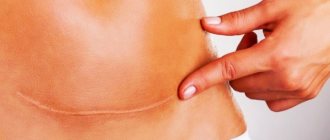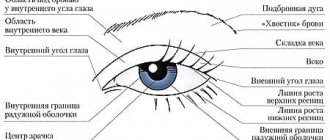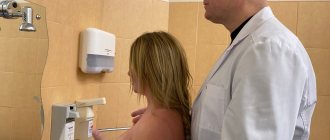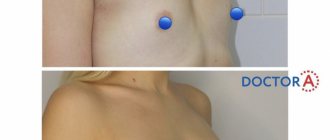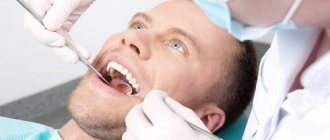More about the operation
Sectoral resection is a surgical intervention to remove a fragment of the mammary gland in which a tumor or suppuration has formed. Sector - is a triangular fragment no larger than 1/6–1/8 of the breast, with its apex facing the nipple. Such a surgical intervention is used in the presence of large benign neoplasms that contribute to a change in the shape of the breast or a suspected oncological nature of the tumor.
Advantages of sectoral resection:
- avoids total mastectomy;
- performing the operation under visual ultrasound control allows you to accurately determine the location of the pathological focus;
- Only damaged tissue is excised, so the shape and aesthetics of the breast do not undergo significant changes.
The intervention is low-traumatic and is characterized by rapid healing and a short recovery period.
Techniques
An implant after a mastectomy cannot be installed immediately due to a lack of tissue in the breast area. It is replenished using:
- the patient's own tissues;
- expander;
- own tissues and expander.
An expander is a subcutaneous expander that is gradually filled with saline over 2-6 months to stretch the tissue for the purpose of subsequent implantation of a silicone endoprosthesis.
The patient’s own tissues can be removed from various areas:
- obtaining a flap from the area under the breast;
- TRAM (a flap consisting of skin and subcutaneous fat excised from the abdominal area);
- TDL (back flap).
A silicone implant is placed in a stretched pocket of skin, and the breast is modeled using one’s own tissue. After healing, the nipple-areolar complex is reconstructed. Sometimes healthy breasts are also adjusted to achieve maximum naturalness.
Cost of sectoral breast resection
The prices indicated in the price list may differ from the actual prices. Please check the current cost by calling +7 495 104 8605 (24 hours a day) or at the GMS Hospital clinic at the address: Moscow, st. Kalanchevskaya, 45.
| Name | Price |
| Removal of mammary glands for gynecomastia (bilateral) | RUB 125,006 |
Dear Clients! Each case is individual and the final cost of your treatment can only be found out after an in-person visit to a GMS Hospital doctor. Prices for the most popular services are indicated with a 30% discount, which is valid when paying in cash or by credit card. You can be served under a VHI policy, pay separately for each visit, sign an agreement for an annual medical program, or make a deposit and receive services at a discount. On weekends and holidays, the clinic reserves the right to charge additional payments according to the current price list. Services are provided on the basis of a concluded contract.
Plastic cards MasterCard, VISA, Maestro, MIR are accepted for payment. Contactless payment with Apple Pay, Google Pay and Android Pay cards is also available.
Western standards of treatment (evidence-based medicine)
Continuous staff development
Regular interaction with leading Russian and foreign medical institutions
Modern medical equipment and advanced diagnostic and treatment methods
Unified standard of service
We work around the clock 24/7/365
Make an appointment We will be happy to answer any questions Coordinator Oksana
Why is it better to undergo sectoral breast resection at GMS Hospital?
Breast surgeons at GMS Hospital were among the first to begin performing operations using this technique, and certain modifications of surgical treatment are carried out only here. Among the main advantages of visiting the GMS surgery center:
- the ability to perform surgery under visual control, which significantly increases the effectiveness of therapy and reduces the possibility of complications;
- the presence of modern equipment can significantly reduce surgical trauma, so more often than not, the outline of the mammary gland does not change much;
- the cosmetic defect that occurs after the intervention can be easily eliminated and does not require such extensive surgery as breast plastic surgery after a total mastectomy.
In most cases, surgery is performed using minimally invasive techniques, which significantly reduces the recovery period and does not require hospitalization. You can make an appointment for a consultation with a mammologist around the clock - by phone or online.
Rehabilitation after mastectomy
Gymnastics is a mandatory part of rehabilitation. They begin to do it in the hospital, often “through pain.” Physical exercise will eliminate stooping and curvature of the spine, restore arm mobility, relax the shoulder and neck muscles, and reduce pain. With their help, patients “learn” again to perform everyday activities: combing their hair, raising their arms, etc. If there are no complications, exercise therapy begins 7 days after surgery. The set of exercises is selected individually. Exercises on exercise machines and in the pool are also effective. Physiotherapy may be prescribed, although its use for cancer patients is controversial. Physiotherapy methods include electrophoresis, photodynamic therapy, etc.
Indications for surgery
Indications for sectoral resection of the mammary gland are:
- breast fibroadenomas more than 2 cm in diameter, accompanied by pain;
- leaf-shaped (phylloid) fibroadenomas;
- intraductal papilloma;
- nodular mastopathy;
- single or multiple (located in one segment) lipomas;
- nodular adenosis of the mammary gland (if its malignancy is confirmed);
- a malignant tumor no more than 3 cm in diameter, located in the outer upper quadrant of the breast;
The operation is not performed during pregnancy and breastfeeding, with existing acute inflammatory and infectious processes and severe cardiovascular pathologies in the decompensation stage.
Methods of detection
The earlier the disease is detected and treatment started, the greater the chances of a speedy recovery. To do this, several hardware visualization methods are used:
- ultrasonography;
- CT scan;
- microwave radiothermometry (RTM);
- positron emission tomography (PET system).
At the slightest suspicion of cancer, a puncture biopsy is performed, tests are taken for tumor markers to exclude a malignant process and determine its likelihood, and a full gynecological examination is performed. If the benign nature of the lesion is confirmed, it is still recommended to remove it to avoid degeneration. You cannot try to get rid of it by self-medicating with the help of devices, applying compresses, warming up on the advice of friends or online sources. This can provoke an increase in fibroadenoma.
Preparation, diagnostics
Before surgery, it is necessary to undergo a comprehensive examination, including:
- consultation with a mammologist;
- Ultrasound of the mammary glands;
- fine needle or core biopsy;
- mammography (for patients over 35 years old);
- a standard set of blood tests, including hormones and tumor markers;
- urine tests;
- ECG;
- fluorography;
- consultations with specialized specialists - therapist, oncologist, anesthesiologist, gynecologist, cardiologist.
Preoperative examination can be completed in our center in just a day. The surgeon will determine what research methods are required in a given clinical situation during the consultation. To clarify the objective picture of the disease and the patient’s condition, other examinations may be necessary.
How is the operation performed?
Sectoral resection of the mammary gland can be performed under local (if the tumor is well palpated) and general anesthesia. The type of anesthesia is selected individually. The surgeon first marks the incision lines and then makes semi-oval incisions along the marked boundaries from the periphery to the nipple. Identifies the pathological focus and excises it along with nearby tissues. Depending on the size of the tumor, the volume of excised tissue ranges from 1–3 cm.
After removing the modified tissues, the bleeding is stopped, drainage is installed in the wound, sutured in layers and a sterile bandage is applied. The operation lasts 30–40 minutes. The drainage catheter is removed the next day. GMS Hospital specialists use a cosmetic suture when suturing the wound. It involves more precise matching of edges, no puncture of the skin, and placement of suture material inside the wound. The use of a cosmetic suture makes it possible to minimize the size and shape of a surgical scar.
If histology is performed during the operation, the wound is not sutured, but temporarily closed. After receiving the result, the surgeon either sutures the surgical wound or expands the scope of the intervention.
You have questions? We will be happy to answer any questions Coordinator Tatyana
Clinical signs
At the beginning of its development, fibroma is a small, round-shaped neoplasm that does not cause pain when pressed. A few days before menstruation, a feeling of fullness may appear at the site of its localization. As it grows, detection is no longer difficult, since the pathological focus is well palpated.
Symptoms directly depend on the stage of development and origin of fibroadenoma. All its types differ in histological type, location and are divided into forms:
- pericanalicular - a growth that is homogeneous in structure and dense in consistency, concentrated around the ducts and isolated from other tissues;
- intracanalicular - has a lobular structure and unclear contours with growth into the lumen of the ducts without clearly defined boundaries;
- mixed - having characteristics of both types.
All of them are not predisposed to malignancy, but sometimes a leaf-shaped or phylloid form occurs, characterized by accelerated growth rates (up to 30 cm in volume in 6 months) and larger sizes. It is she who has a tendency to degenerate into sarcoma.
Features of the rehabilitation period
Depending on the scope of the operation, the patient can spend in the hospital from several hours to a day. The recovery period takes 10–14 days. In order for this period to pass quickly and without problems, it is necessary to scrupulously follow all the recommendations and instructions of the attending physician:
- perform dressings regularly;
- refuse to visit the solarium, bathhouse, swimming pool, sauna;
- limit physical and sports activities;
- wear comfortable clothes that do not restrict movement and do not rub in the chest area.
- Wear a supportive bra (24 hours a day).
- Eat foods rich in protein and vitamin C.
- after removing the sutures, do special therapeutic exercises.
- at the slightest suspicious changes in the operated area, immediately consult a doctor.
High-quality surgical intervention minimizes postoperative deformation of the mammary gland. Sectoral resection at the GMS Hospital surgical center is an effective surgical treatment using advanced developments, experienced doctors and a high cosmetic effect. To make an appointment with a mammologist, call or leave a request on the website.
Possible complications
Most often the operation goes well. Immediately after surgery, you may experience some minor bruising and swelling. This is normal after surgery and no special treatment is required. Bruising and swelling usually go away on their own within 1-2 weeks.
In isolated cases, after surgery there is a risk of the following complications:
- seroma formation (this occurs due to damage to the lymphatic vessels, which slowly thrombose);
- inflammatory process with suppuration (if the wound was infected) and a sharp increase in temperature;
- the occurrence of a hematoma (when a damaged vessel is missed or a suture breaks).
In what cases is it necessary to consult a doctor immediately:
- Increased body temperature.
- Seam separation on the chest.
- Supuration of the suture.
- Release of fluid in the seam area.
- Acute pain that gets worse.
